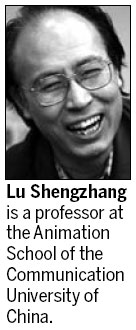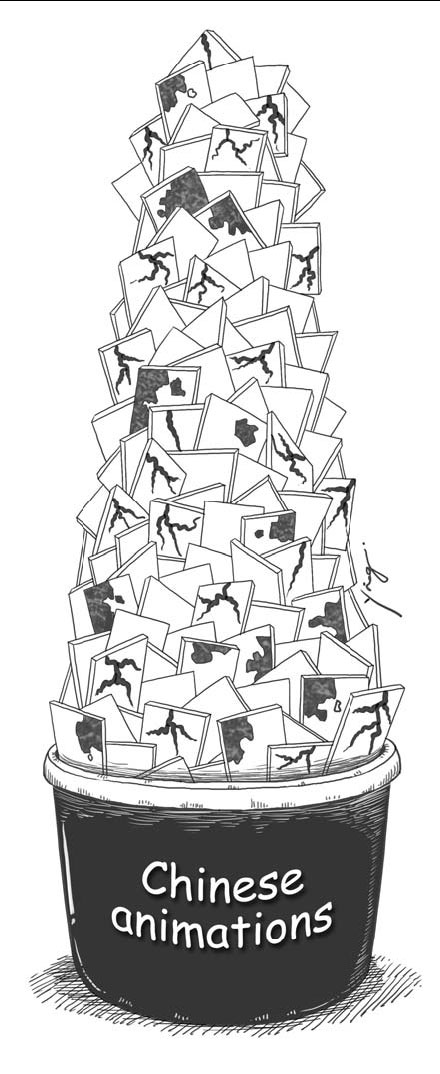
The 2011 China Animation and Comic Industry Development Report shows the total output of the Chinese animation industry last year ran into 228,000 minutes. This means China has overtaken Japan as the largest animation production center in the world.
But the achievement is a cause for worry rather than pride for Lu Shengzhang, professor at the Animation School of the Communication University of China.
Although the government has spent huge amounts to set up bases for the animation industry and poured a lot of money into animation productions, few results have been sweet. Only a few respectable works from among those that ran into 228,000 minutes could win public praise. Countless low-quality animations, including cartoons, TV programs and films, were made, many of which cannot be even shown, let alone make profit.
"Without quality there's no animation industry," says Lu, who was the chief director of the promotional animation video of Beijing 2008 Olympic Games mascot Fuwa. He has repeatedly appealed to the authorities and artists in the animation industry to shift their focus from quantity to quality, because "China cannot become a leading animation production center by making a great 'quantity' of low-quality products". Besides, low-quality cultural products cannot be reused and thus are a total waste of money.
Lu concedes that the Chinese animation industry has a lot of catch-up to do before reaching the advanced level. The main cause of the sorry state of affairs, he says, is the lack of marketization and specialization. In the past, "we regarded animation as art rather than commodity and that impeded its industrial development."
Until the 1980s, more than 30 Chinese animated cartoons had won dozens of international awards, and the special style of Chinese animation was even recognized as a gift of the "China school", Lu says. "Regrettably, at that time we did not think of making profit from animated productions not to mention developing peripheral products and protecting intellectual property rights."
Although China has realized the importance of marketization for the industry in recent years, its animation industry is still immature. Neither is there a complete operating procedure that includes financing, marketing and production to follow, nor is there a successful operation case to learn from.
Furthermore, the specialization level of China's animation industry is still comparatively low. "We lack not only qualified professionals and talents, but also a professional operation system such as market research and marketing strategy." An animation's quality can hardly be guaranteed without pre-assessment and a post-evaluation mechanism. "How can we make good animated cartoons if we don't know the taste of audiences?"
The entire industry is somewhat eager to achieve instant success, but cultural products are not made or created in one stroke, Lu says. "Be professional and concentrate on your work, and there could be a leap in the development of China's animation industry." This is his advice to the animation industry.
The contents of domestic animations, too, have invited public criticism. Hollywood animation productions have exhilarated Chinese audiences one after another. After Kung Fu Panda 2, which even sparked a debate on whether it was a cultural invasion, The Smurfs have won Chinese children's hearts.
Lu says the main problem with Chinese animations lies in the way they express the core values to attract audiences. Chinese animations focus too much on cultural characteristics and ignore widely accepted core values, which is the key to winning people's appreciation. "And, we still have much to improve to be able to tell a story with universal values in a creative but Eastern way."
Lu rejects some people's appeal to boycott foreign animation productions in the name of resisting cultural aggression. He says that learning from the advantages that foreign animations have is the first step toward improving our productions. It is also the right "power mentality" that China should have. Although some protective policies are necessary and acceptable for cultivating the domestic animation industry, they should be temporary and transitional. "The most important thing is to produce our own good works."
Lu sees hope in China's new generation because of their creativity and ability to spread their works through new media. The new generation nails the lie that Chinese people lack imagination and creativity. But the production and promotion of animations, especially animated films, require huge investments of money and time, which is difficult for just one person to generate.
To cultivate the animation industry, Lu says the authorities should have the strategic foresight to support good works, because their long-term economic and social benefits are incredible. They should set up a funding mechanism to support animation productions, too. Financial support and a complete set of operation mechanism will help Chinese talents to produce excellent works, and strengthen China's animation industry.
(China Daily 08/19/2011 page9)
